How to Create a Well-Rounded Grazing Board, the Easiest Way to Feed a Crowd
Here's how to assemble your most impressive party platter ever, filled with meats, cheeses, fruits, vegetables, and a few surprises.
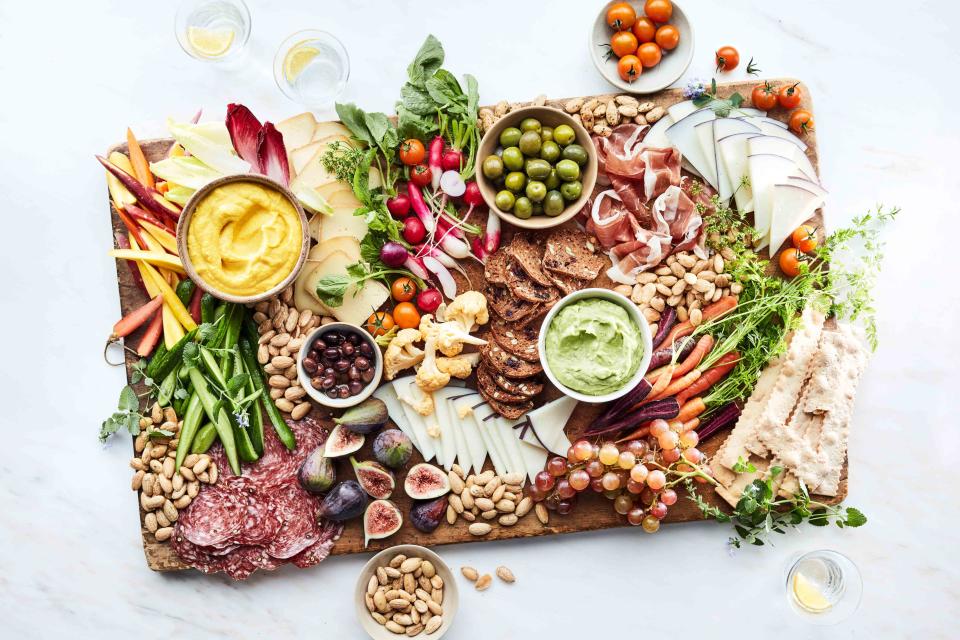
Our answer to easy entertaining: a grazing board piled high with irresistible temptations. A snack lover's dream, this packed platter not only brings together crudités, cheese, and charcuterie, it also unites your guests. After all, there's no better way to bond than over a cracker stacked with Smoked Trout Pate or a nibble of prosciutto or speck. (Oh, and please pass a handful of Castelvetrano olives!)
The best part about this interactive cornucopia is that it requires no cooking, extensive preparation, or complicated hors d’oeuvres—you simply let everyone help themselves to whatever they fancy while you pour them a glass of bubbly or mix up a festive aperitif. Here are some grazing board ideas to get your party started. (Just make sure to leave room for dinner!)
Related: These Creative Food Boards Are Your Answer to Easy Holiday Entertaining
Start With a Large Board
We have plenty of grazing board ideas, but before the assembling stage starts, it's best to select an oversized board. Make sure that it's large enough to artfully arrange each item while maintaining visual order. Think of it as a blank canvas for swirling and layering flavors, colors, and textures and making an aesthetically appealing presentation.
Rustic boards made from olive wood, bamboo, or oak, and elegant boards fashioned from slate or marble, are all viable, easy-to-maintain options, You can opt for a board that is oblong and hand-carved or round and centerpiece-worthy, but most importantly, make sure the surface is food-safe. If you don't have an oversized option, arrange multiple pieces side by side.
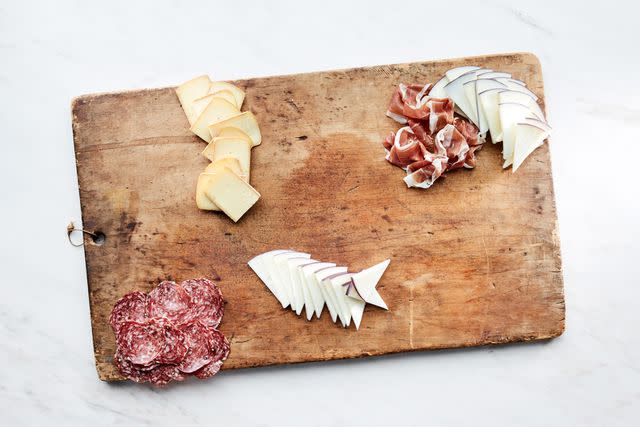
Prepare Your Food
Whether you're pulling together a holiday grazing table or a plentiful platter, aim for handheld morsels, positioning complementary flavors within proximity. Cut every item that goes on the board so it is ready to eat. Keep slices to one or two bites, allowing guests to try a bit of everything without getting too full. Leave the cheese knives for the cheese board; this is an eat-with-your-hands experience.
Start with the main ingredients: cheese, meats, and dips are the building blocks of the board. Space each out in their own area, then place items around them to indicate what pairs well together. or lends a delicious contrast. Feel free to suggest some of your favorite combinations.
Cheeses
Choose two or three different cheeses. Each should be different in color, shape, and flavor. Manchego and Drunken Goat both have beautiful edible rinds and slice into sharp triangles. Or, cut a fancy Swiss-style cheese or a Gouda with rounder edges in half; then slice crosswise for a different shape. Alternatively, crumble aged cheddar or Parmesan into bite-sized bites.
Once you've selected and sliced your cheeses, divide the platter into two or three segments—then select an area for each cheese. Fan slices in artful overlapping half-moons that beg to be eaten.
Tips
Get ahead by slicing the night before (it's best to do so when the cheese is cold) and gathering the slices back up into a block or wedge. Wrap well in plastic and refrigerate.
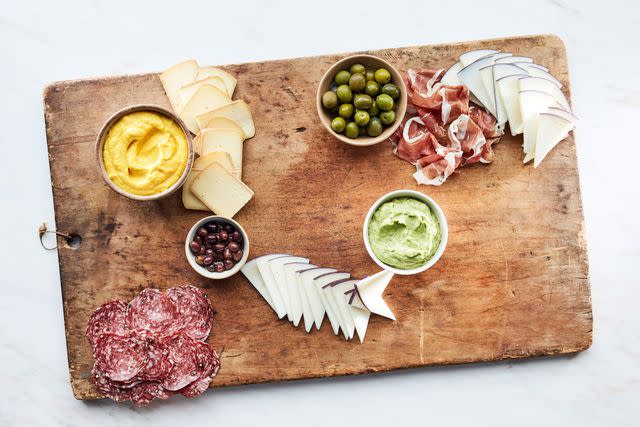
Charcuterie
Some of the most delectable charcuterie hails from Italy, Spain, and France, and some varieties even marry sweet and savory flavors. Select two types of cured meats for your grazing board, like thinly sliced prosciutto di Parma and prosciutto San Daniele, jamón Iberico, speck, and jambon de Bayonne. capicola, or salami.
Choose spaces on either side of the board for each type of charcuterie. Try rolling or folding the meat for an interesting presentation; slice salami thinly.
Related: Our Essential Guide to Cheeseboard Etiquette
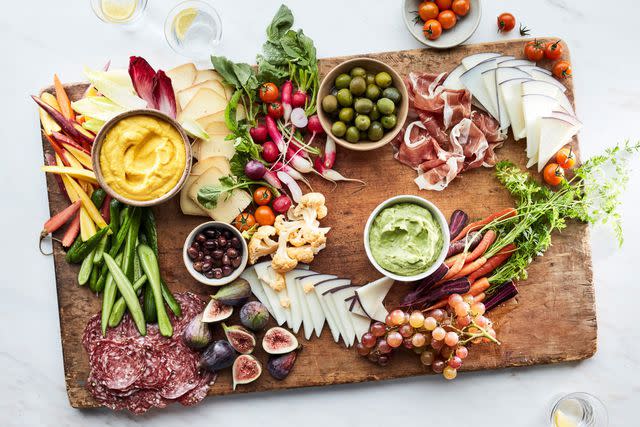
Dips and Spreads
Choose one or two dips that bring new flavors to the board and add pops of color; they should command visual attention. Opt for our creamy green Avocado Ranch Dip and the stunning Beet-and-Tahini Dip (in either red or yellow), or choose from store-bought options.
Place the dips in vibrant, colorful bowls of varying sizes; they'll add dimension and height to the board. Place the bowls in any remaining gaps, leaving enough room around them to arrange some dippers, like crunchy vegetables or zesty Seeded Crackers. Another grazing board idea: Add a few smaller vessels with pickled items, such as olives and cornichons.
Fruit and Vegetables
Select seasonal fruits and vegetables with bright colors, such as radishes, cucumbers, bell peppers, figs, and grapes. Cut the vegetables into different shapes and arrange them in a flowing circular pattern around the dips. Whole carrots turn into elegant baby carrots when you cut them on a strong bias into two-bite pieces.
Leave edible greens on young radishes and baby carrots for eye appeal. Pull apart white-and-red endive and arrange the beautiful two-toned leaves around a bowl. Opt for yellow or purple cauliflower and break into florets.
Place fruits that go particularly well with certain cheeses or meats right next to them. Halved fresh figs, for example, are the perfect counterpoint to meats like prosciutto, and countless cheeses, while grapes are always a welcome nibble.
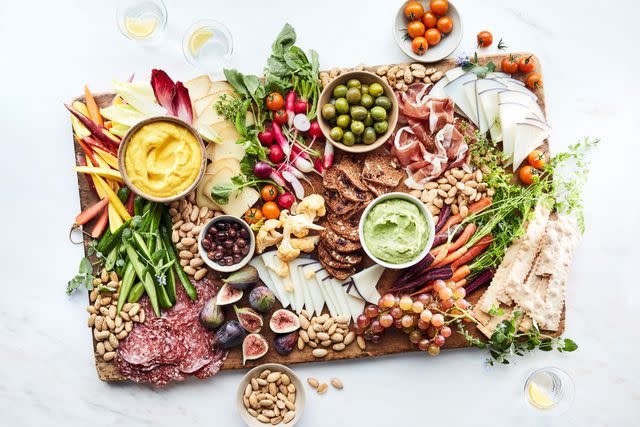
Snackable Crackers
No grazing board is complete without crackers, which are the base of a perfect bite. Pick at least two different types. Try nut and fruit crisps, Lavash crisps, and rustic flatbreads to add shape and texture.
Swirl or stack the crackers into remaining empty spaces. Give them a semblance of order to keep the board looking neat.
Related: How to Assemble the Cheese Board of Your Dreams
Nuts
Complete your board with a selection of your favorite nuts, like almonds, peanuts, and pistachios. Sprinkle nuts in any remaining gaps for a wonderful salty finish. An added bonus: They go nicely with everything on the platter.
Read the original article on Martha Stewart.

